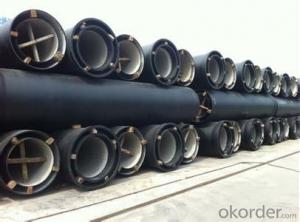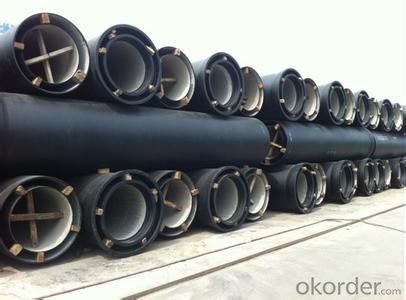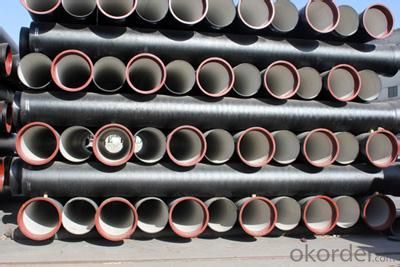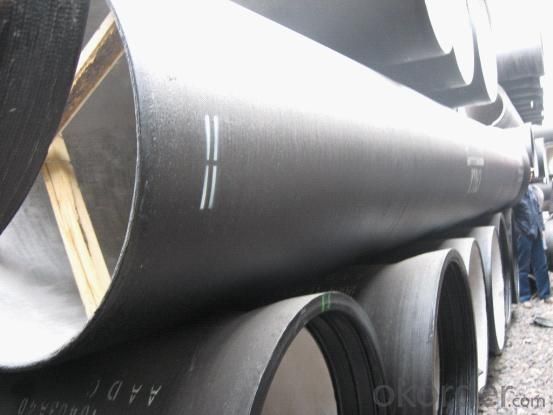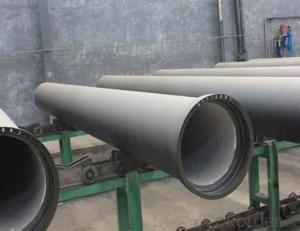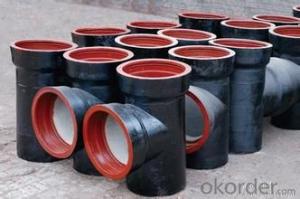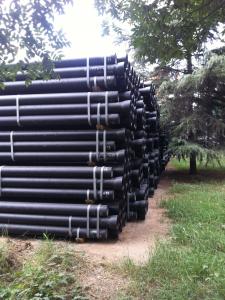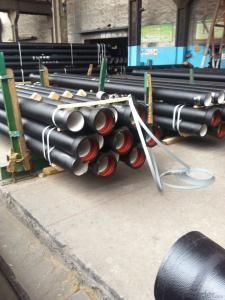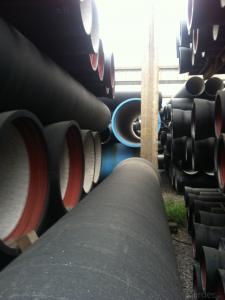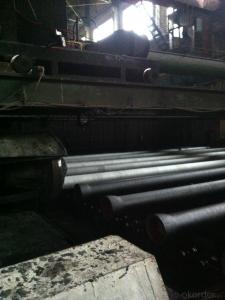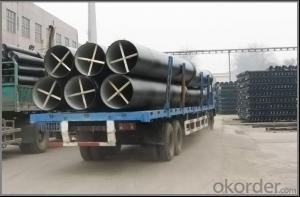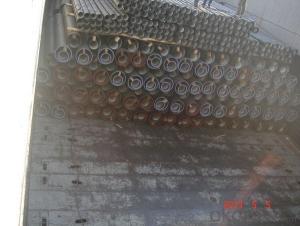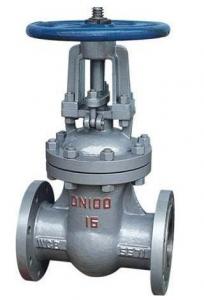DUCTILE IRON PIPE AND PIPE FITTINGS K7 CLASS DN200
- Loading Port:
- Tianjin
- Payment Terms:
- TT or LC
- Min Order Qty:
- 23 m.t.
- Supply Capability:
- 3000 m.t./month
OKorder Service Pledge
OKorder Financial Service
You Might Also Like
Product Discription:
OKorder is offering high quality K7 CLASS DN200 Ductile Iron Pipe and Pipe Fittings at great prices with worldwide shipping. Our Pipe and Pipe Fittings are available in a wide range of styles and materials, and are guaranteed with a full warranty. Our supplier is a world-class manufacturer of Ductile Iron, and our products are utilized the world over, with OKorder annually supplying a full range of products to European, North American and Asian markets. We provide quotations within 24 hours of receiving an inquiry and guarantee a competitive price.
Product Applications:
Our K7 CLASS DN200 Ductile Iron Pipe and Pipe Fittings are incredibly reliable and ideal for potable water transmission and distribution as well as utility projects (water and sewer).
Product Advantages:
OKorder's K7 CLASS DN200 Ductile Iron Pipe and Pipe Fittings are of the highest quality and we offer external coatings and internal linings as well as accessories such as SBR/EPDM rubber gaskets, lubricant paste, pipe caps, PE sleeves, etc. We include a copy of the original inspection reports upon shipment, photos of the loading process sent to the customer, and delivery progress weekly updates
Main Product Features:
· Strict inspections according to related standards
· Easy installation and service-free
· Extended service lifespan
Product Specifications:
Material: Ductile Cast Iron
Sizes: DN 80mm – DN 2000mm
Effective Length: 6m – 5.7m
Standards: ISO 2531:1998 / EN 545:2006 / EN 598:2007
Annual Capacity: 200,000 tons
Coating: Zinc 130g/m² (ISO 8179-1); 70 micron bitumen coating
Cement: Portland Cement / High Alumina Cement / Sulphate Resisting Cement Lining (ISO 4179)
FAQ:
Q1: Why buy Materials & Equipment from OKorder.com?
A1: All products offered by OKorder.com are carefully selected from China's most reliable manufacturing enterprises. Through its ISO certifications, OKorder.com adheres to the highest standards and a commitment to supply chain safety and customer satisfaction.
Q2: How do we guarantee the quality of our products?
A2: We have established an advanced quality management system which conducts strict quality tests at every step, from raw materials to the final product. At the same time, we provide extensive follow-up service assurances as required.
Q3: What is the difference between Cast Iron and Ductile Iron?
A3: Cast iron is a generic name for any high carbon molten iron poured as a casting. When used to refer to pipe, cast iron (sometimes called gray iron) is a specific type in which the free graphite (Carbon) is in the shape of flakes. Ductile Iron is a specific type of cast iron in which the free graphite is in the shape of nodules or spheroids. Although nearly identical chemically, the two irons are quite different metallurgically. The current standard for Ductile Iron Pipe (ANSI / AWWA A21.51 / C151) requires a minimum grade of 60-42-10 (60,000psi Ultimate Tensile Strength, 42,000psi Yield Strength, and 10% Elongation). Although Cast Iron was the best engineering material available for pipe production for nearly five hundred years, the development of Ductile Iron Pipe provides a far superior product.
Q4: How much thermal expansion should I allow for?
A4: The linear expansion of ductile iron pipe as a result of thermal effects is very small, with ductile iron expanding less than concrete. For rubber gasketed joints and mechanical joints assembled in accordance with the manufacturer’s instructions, there is enough clearance from the face of the plain end of the pipe to the back of the bell to account for significant thermal growth before beginning to make metal-to-metal contact. Except for very long runs of exposed piping, particularly if flow is intermittent, thermal expansion is usually not a concern.
Q5: What is the maximum velocity recommended for cement-lined Ductile Iron pipe?
A5: Although there are differing opinions on this subject, a conservative maximum velocity for design purposes is 7 fps (feet per second). Ductile Iron pipe may be rated as high as 350 psi service. A pipeline operating at 7 fps velocity could account for a 350 psi pressure surge (7fps X 50 psi/fps). Adding a potential surge pressure equal to the pressure rating of the pipe encroaches significantly on the safety factor. Exceeding 7 fps velocity could produce potentially damaging surge pressure.
Q6: Can cement-mortar linings be repaired in the field?
A6: Repair is achieved by first cutting out the defective or damaged lining to the metal so that the edges of the lining not removed are reasonably perpendicular to the pipe wall or slightly undercut. A stiff mortar is then prepared and applied to the cutout area and troweled smooth with adjoining lining. To provide for proper curing of patches by preventing too rapid of a moisture loss from the mortar, the patched area is normally seal-coated immediately after any surface water evaporates, or alternatively the area is kept moist (e.g. with wet rags or burlap over the area or with the ends of the pipe or fitting taped over with plastic film, etc.). Of course, in potable water-related applications, no patch or curing components should be used in the repair that would negatively affect health or water quality.
- Q: The difference between HDPE pipe and ductile iron pipe
- Of different uses, ductile iron pipes are widely used for municipal water supply and drainage, rural drinking water and outdoor fire fighting works; mechanism cast iron pipes are mainly used in the city.
- Q: How are ductile iron pipes protected against freeze-thaw cycles?
- Ductile iron pipes are protected against freeze-thaw cycles by using a combination of insulation, proper installation techniques, and the addition of corrosion inhibitors or anti-freeze agents in the water supply. This helps prevent the expansion and contraction of the pipes caused by freezing and thawing, reducing the risk of damage or cracking.
- Q: Will the cast iron pipes rust?
- Qualified ductile iron pipe requires lining standard cement. The outer wall of pipe needs spraying zinc treatment and asphalt paint coating, and other epoxy resin paint can also be selected.
- Q: What are the meanings of cast iron pipe wall thicknesses LA, A and B respectively?
- Cast iron pipes (Cast, Iron, Pipe), cast cast pipe. Cast iron pipes are used for water supply, drainage and gas transmission lines. They include cast iron pipes and pipe fittings. Labor intensity is small. According to the casting method, it is divided into continuous cast iron pipe and centrifugal cast iron pipe, in which the centrifugal cast iron pipe is divided into sand mould and metal type two kinds. Divided into gray cast iron pipe and nodular cast iron pipe according to different material. According to the interface form, it is divided into flexible interface, flange interface, self anchored interface, rigid interface and so on. Among them, the flexible iron pipes rubber sealing ring; flange interface cast iron pipe flange fixed in the rubber pad, the flange gasket sealing; rigid interface cast iron pipe socket is large, straight pipe is inserted, sealed with cement, this technology has been basically eliminated.
- Q: Principles for the antiseptic treatment of ductile iron pipes
- Anti corrosion process of ductile iron pipe:1. asphalt paint coatingBituminous paint coatings are pipes used to carry gas. Preheating the pipe before spraying can improve the adhesion of asphalt paint and accelerate drying.2. cement mortar lining + special coatingThe internal corrosion prevention measures are suitable for pipes conveying sewage, and the corrosion resistance of lining can be improved.3. epoxy coal tar coatingThe epoxy coal tar coating is not only suitable for gas pipelines, but also for sewage pipes. It is a two component coating with a high adhesion and a very smooth surface
- Q: How do ductile iron pipes handle thermal cycling in industrial applications?
- Ductile iron pipes are known for their exceptional ability to handle thermal cycling in industrial applications. Thermal cycling refers to the fluctuation in temperature that occurs during the operation of various industrial processes. These pipes are designed to withstand the stresses caused by thermal expansion and contraction, making them highly suitable for environments with significant temperature variations. One of the key characteristics of ductile iron pipes is their high thermal conductivity. This means that they can efficiently conduct heat away from the hot areas, minimizing the impact of thermal cycling. Additionally, ductile iron pipes have a low coefficient of thermal expansion, which means that they expand and contract at a slower rate compared to other materials. This helps to reduce the stresses imposed on the pipes during thermal cycling. Furthermore, ductile iron pipes have excellent mechanical properties, including high tensile strength and impact resistance. These properties enable the pipes to withstand the mechanical stresses that may arise due to thermal cycling. They can resist the formation of cracks or fractures, ensuring the integrity and longevity of the pipes in industrial applications. Moreover, ductile iron pipes have a high resistance to corrosion and oxidation. This is particularly important in industrial settings where the pipes may be exposed to aggressive chemicals or harsh environments. The corrosion resistance of ductile iron pipes ensures that they can withstand the corrosive effects of the process fluids and gases, even during thermal cycling. In summary, ductile iron pipes are well-equipped to handle thermal cycling in industrial applications. Their high thermal conductivity, low coefficient of thermal expansion, excellent mechanical properties, and resistance to corrosion make them a reliable choice for environments with significant temperature variations. These pipes can effectively withstand the stresses caused by thermal cycling, ensuring their durability and longevity in industrial settings.
- Q: What is the purpose of ductile iron pipes?
- Ductile iron pipes serve the crucial function of establishing a dependable and sturdy infrastructure for fluid transportation, including water, sewage, and gas. In comparison to steel or PVC pipes, ductile iron pipes offer notable advantages. One primary objective lies in ensuring the secure and efficient distribution of water to communities. Ductile iron pipes are specifically designed to endure high pressures and endure the challenging conditions found underground, rendering them an excellent choice for water supply systems. With their extended lifespan and minimal maintenance requirements, the necessity for frequent repairs or replacements is greatly reduced. Another purpose involves the efficient conveyance of sewage and wastewater. Ductile iron pipes possess exceptional resistance to corrosion, guaranteeing their ability to withstand the corrosive properties of sewage and other waste materials. Additionally, their structural strength enables them to endure heavy loads and ground movements, making them well-suited for underground sewer systems. Ductile iron pipes are also employed for gas transportation. Their remarkable mechanical properties empower them to withstand applications involving high pressures, making them the ideal choice for gas distribution networks. Furthermore, their durability and resistance to external factors like soil movement or temperature changes establish them as a reliable option for gas transmission systems. In essence, the overarching purpose of ductile iron pipes is to provide a resilient and enduring solution for the safe and efficient transportation of fluids. By contributing to the development and maintenance of essential infrastructure systems, they effectively support the needs of our communities.
- Q: Water supply pipe is ductile iron, then it's fittings and valves and other parts must be ductile iron?
- Ductile iron pipe end rubber ring interface should belong to flexible connection. It should be the way to connect the clamps. Then, the valve is also connected to the card sleeve connection.
- Q: The difference between spheroidal graphite cast iron pipe and HDPE water supply pipe
- HDPE pipe is made of hot melt butt joint, and the strength of interface is very good. Ductile iron pipes are made of socket joint, and reinforced concrete piers shall be rammed on three links, elbows and other parts. In this regard, the cost of natural selection of ductile iron pipe, HDPE pipe than the choice of high.
- Q: How can the steel plastic composite pipe be connected with the cast iron pipe?
- Use stainless steel clamps to connect.
Send your message to us
DUCTILE IRON PIPE AND PIPE FITTINGS K7 CLASS DN200
- Loading Port:
- Tianjin
- Payment Terms:
- TT or LC
- Min Order Qty:
- 23 m.t.
- Supply Capability:
- 3000 m.t./month
OKorder Service Pledge
OKorder Financial Service
Similar products
Hot products
Hot Searches
Related keywords
